Tourist Attraction in Amritsar
Amritsar Tourist Attraction
- Holy City - Amritsar
- Amritsar is a holy city in the state of Punjab, India and its name derives from the name of the pool around the Golden Temple (Harmandir Sahib) and means "holy pool of nectar". It is the spiritual and cultural center of the Sikh religion, and they are rightfully very proud of the city & their very beautiful and unique Gurdwara. Amritsar is one of the most ancient and fascinating cities of India. It is an important seat of Sikh history and culture. Being the gateway for travellers coming to India on the overland route from central Asia it soon became the centre of various commercial activities. Amritsar has various historical and religious sites. The most famous of them all in the Golden Temple which was founded by the fourth Guru of Sikhs, Guru Ramdas and completed by his successor Guru Arjan Dev. Another revered shrine is the Durgiana Temple which is dedicated to goddess Durga. The museum at Ram Bagh houses weapons dating back to Moghul times and some portraits of the ruling houses of the Punjab. The Jallianwala Bagh at Amritsar reminds the visitor of one of the most heart-rending events in the history of India. Bullet marks and the well into which some people jumped to escape the onslaught can still be seen. Some other attractions are the Fort Gobind Garh which was built by Maharaja Ranjit Singh and the Tarn Taran tank which is 25 kilometres south of Amritsar.

- The Golden Temple
- Amritsar, home to the Golden Temple is one of the most ancient and fascinating cities of India. It is an important seat of Sikh history and culture. Being the gateway for travellers coming to India on the overland route from central Asia it soon became the centre of various commercial activities. There are various historical and religious sites - see Amritsar City Map. The most famous of them all in the Golden Temple which was founded by the fourth Guru of Sikhs, Guru Ramdas and completed by his successor Guru Arjan Dev.

- Indo-Pak Wagah Border
- Wagah Border is located at a distance of 28 kilometers from Amritsar. It is the only border crossing between India and Pakistan. It is an army outpost to protect check intrusion from Pakistan and prevents any Indian from going to Pakistan. Special buses and taxes from Amritsar take the tourists to Wagah Border. En route Wagah the tourists chance upon seeing some of the most fertile lands of Amritsar.At the border outpost there is a complex of buildings, roads and barriers on both sides. At the entrance of this outpost, there is a sightseeing gate with an inscription "Swarna Jayanti". From this a panoramic view of the landscape is seen.
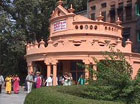
- Jallianwala Garden
- It gained its place in the annals of the Indian freedom struggle when British General Reginald Dyer mercilessly gunned down hundreds of innocent men, women and children who had gathered in the park on the day of Baisakhi in 1919. The park symbolizes the atrocities committed by the British on the Indian soil.
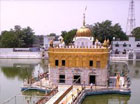
- Durgiana Temple
- Punjab is a land blessed by saints, an ancient land yielding archaeological treasures, a land of palaces and temples. Situated outside the Lohgarh Gate, Durgiana Temple is built after the design of the Golden Temple and attracts sages and scholars in Hindu scriptures from all over India. A walk away from the Golden temple complex through the narrow passageways brings the visitors to the 16th century Hindu temple of Durgiana.
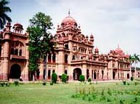
- Khalsa College
- The oldest college of Amritsar was established in distinctive mix of Mughal and Sikh architecture in the year 1892 by the Singh Sabha Movement. The college campus is spread over more that 300 acres and has that distinctive charm with red minarets and domes against the lush green backdrop.

- Fort Gobindgarh
- Previously known as Bhangian Da Killa, the Gobindgarh Fort located in the South-West of Amritsar was built in 1760 by the army of Gujjar Singh Bhangi of Misl (the 12th Sikh Guru). Later in 1805-09, it was rebuilt by Maharaja Ranjit Singh with the help of Jodh Singh and he strengthened the fortification of the fort in order to keep his treasures and treaties in safety. Gobindgarh Fort was constructed with brick and lime on a square pattern with a parameter of 1500 square meter with two strong gates, four large bastions and well-defined rampart. The magnificent main entrance is called Nalwa Gate and the other gate known as Keelar Gate is said to have a connected with the tunnel of Lahore, which is used to escape from the enemies. There were 25 cannons on the ramparts and they are now replaced with modern weaponry. In the center of the fort there is a Toshakhana, which is specially constructed to store a huge amount of food and grains for the 12,000- army men. After the annexation of Punjab, the fort was occupied by the British Army and they had added Darbar Hall, Hawa Mehal and Phansi Ghar (hanging place) to the fort. After separation, it offers a temporary protection to a large number of immigrants from Pakistan . The fort that occupies a unique place in Indian military history has been taken over by the Indian army in October 1948 and it is now under the administration of Indian Defense Force. In December 2006, the Punjab Chief Minister Captain Amrinder Singh had declared to open the fort for general public and tourists
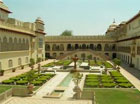
- Maharaja Ranjit Singh Panorama (Ram Bagh)
- This beautiful garden is named as a tribute to Guru Ram Das, the founder of the city. It is situated in the new part of town and has a museum in the summer palace built by the Sikh Maharaja Ranjit Singh (1780-1839) the Lion of Punjab. The museum contains weapons dating back to Mughal times and ssome portraits of the ruling houses of the Punjab and a replica of the diamond (Kohinoor). To commemorate the memory of his valour Ram Bagh has a lively statue of Maharaja Ranjit Singh saddled on a horse. It is closed on Wednesdays.
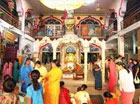
- Vaishno Mata Mandir, Model Town
- One of the most popular Hindu pilgrimage sites of the state of Punjab, the Mata Mandir Temple is a prime Amritsar Tourist Attraction. The Mata Mandir Temple of Amritsar is located at the Rani Ka Bagh area of the city.
Amritsar's Mata Mandir Temple was built in the model of the famous Vaishno Devi Temple of Katra, Jammu. The Mata Mandir Temple is an eternal favorite with the Hindu pilgrims and other religiously inclined people too. It has emerged as a popular haunt for the tourists coming to the city as well. Not only it has immense religious sentiments attached to it but it has considerable archaeological importance also.
The Mata Mandir Temple in Amritsar is visited by thousands of devotees and followers every year. The temple witnesses maximum gathering during the festivals. The Mata Mandir Temple is conveniently situated very close to the north western part of Amritsar Railway Station.

- The Main Market of the Walled City
- It sure is an interesting place to visit. The main mode of transport is the three wheeled rickshaw. The market has countless shops selling Amritsar memorabilia to the modern electronic gadgets. The fascination of the Punjabis with milk and sweet can be seen here. You will find a sweet shop at every corner and the distinctive shallow utensils filled with simmering thickened milk. A glassful of this health drink served in the characteristic style will unquestionably rejuvenate you.










